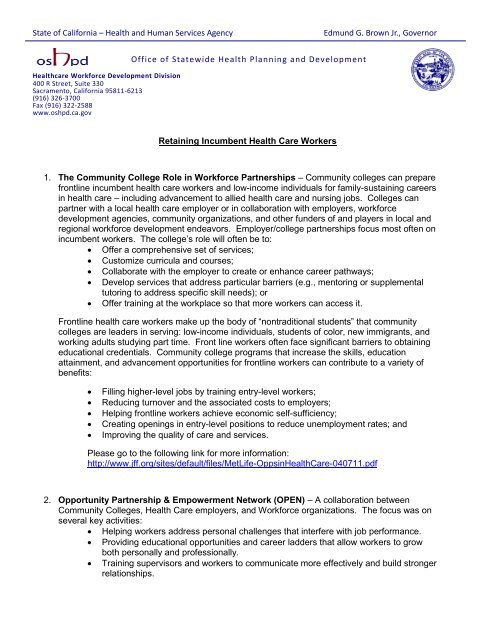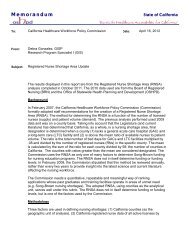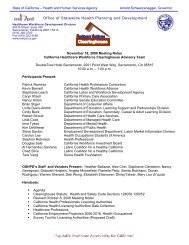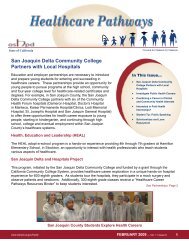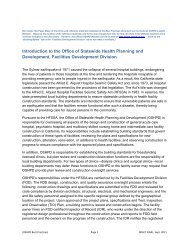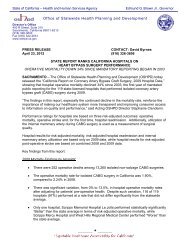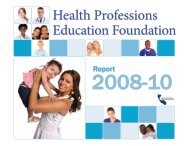Retaining Incumbent Health Care Workers - Office of Statewide ...
Retaining Incumbent Health Care Workers - Office of Statewide ...
Retaining Incumbent Health Care Workers - Office of Statewide ...
Create successful ePaper yourself
Turn your PDF publications into a flip-book with our unique Google optimized e-Paper software.
State <strong>of</strong> California – <strong>Health</strong> and Human Services Agency<br />
Edmund G. Brown Jr., Governor<br />
<strong>Health</strong>care Workforce Development Division<br />
400 R Street, Suite 330<br />
Sacramento, California 95811-6213<br />
(916) 326-3700<br />
Fax (916) 322-2588<br />
www.oshpd.ca.gov<br />
<strong>Office</strong> <strong>of</strong> <strong>Statewide</strong> <strong>Health</strong> Planning and Development<br />
<strong>Retaining</strong> <strong>Incumbent</strong> <strong>Health</strong> <strong>Care</strong> <strong>Workers</strong><br />
1. The Community College Role in Workforce Partnerships – Community colleges can prepare<br />
frontline incumbent health care workers and low-income individuals for family-sustaining careers<br />
in health care – including advancement to allied health care and nursing jobs. Colleges can<br />
partner with a local health care employer or in collaboration with employers, workforce<br />
development agencies, community organizations, and other funders <strong>of</strong> and players in local and<br />
regional workforce development endeavors. Employer/college partnerships focus most <strong>of</strong>ten on<br />
incumbent workers. The college’s role will <strong>of</strong>ten be to:<br />
Offer a comprehensive set <strong>of</strong> services;<br />
Customize curricula and courses;<br />
Collaborate with the employer to create or enhance career pathways;<br />
Develop services that address particular barriers (e.g., mentoring or supplemental<br />
tutoring to address specific skill needs); or<br />
Offer training at the workplace so that more workers can access it.<br />
Frontline health care workers make up the body <strong>of</strong> “nontraditional students” that community<br />
colleges are leaders in serving: low-income individuals, students <strong>of</strong> color, new immigrants, and<br />
working adults studying part time. Front line workers <strong>of</strong>ten face significant barriers to obtaining<br />
educational credentials. Community college programs that increase the skills, education<br />
attainment, and advancement opportunities for frontline workers can contribute to a variety <strong>of</strong><br />
benefits:<br />
<br />
<br />
<br />
<br />
<br />
Filling higher-level jobs by training entry-level workers;<br />
Reducing turnover and the associated costs to employers;<br />
Helping frontline workers achieve economic self-sufficiency;<br />
Creating openings in entry-level positions to reduce unemployment rates; and<br />
Improving the quality <strong>of</strong> care and services.<br />
Please go to the following link for more information:<br />
http://www.jff.org/sites/default/files/MetLife-Oppsin<strong>Health</strong><strong>Care</strong>-040711.pdf<br />
2. Opportunity Partnership & Empowerment Network (OPEN) – A collaboration between<br />
Community Colleges, <strong>Health</strong> <strong>Care</strong> employers, and Workforce organizations. The focus was on<br />
several key activities:<br />
Helping workers address personal challenges that interfere with job performance.<br />
Providing educational opportunities and career ladders that allow workers to grow<br />
both personally and pr<strong>of</strong>essionally.<br />
Training supervisors and workers to communicate more effectively and build stronger<br />
relationships.
An occupational enhancement coordinator was hired for the two-year pilot program. The<br />
employers participating in the program contributed a share <strong>of</strong> the expenses for the program<br />
coordinator and core services. The goals <strong>of</strong> the pilot program include:<br />
<br />
<br />
<br />
<br />
<br />
Assisting employees with advancing within participating companies.<br />
Reduce turnover rates in participating companies.<br />
Use emergency and social supports in order to remove barriers in people’s lives that<br />
could negatively affect employment.<br />
Remain financially self-sufficient by proving to be a cost-effective means <strong>of</strong> service<br />
delivery that ultimately helps the bottom line <strong>of</strong> business while immediately helping<br />
employees.<br />
Increase number <strong>of</strong> employer companies that participate in OPEN.<br />
Please go to the following link for more information:<br />
http://www.directcareclearinghouse.org/download/OPEN%20Report%20final.pdf<br />
3. Hospital Employee Education and Training (HEET) Program – funded by the Washington<br />
State legislature to address concerns related to the shortage <strong>of</strong> qualified healthcare workers.<br />
The aim <strong>of</strong> the initiative was to address the shortage <strong>of</strong> skilled healthcare workers through the<br />
support <strong>of</strong> incumbent worker training programs developed and implemented through<br />
partnerships among labor, management, and community and technical colleges.<br />
<strong>Care</strong>er ladders within hospitals provide workers with an opportunity to move out <strong>of</strong> entry-level<br />
jobs into better jobs with higher salaries. Having a career ladder and promoting from within<br />
helps employers recruit employees who want to advance, and it helps workforce retention.<br />
Turnover among recent graduates hired by hospitals is the highest in the first two years and is<br />
costly and disruptive to the organization. According to one recent study, every percentage point<br />
increase in nurse turnover costs the average hospital $300,000 per year, and hospitals that<br />
have high nurse turnover spend about $3.6 million more than hospitals that have high retention<br />
<strong>of</strong> nurses.<br />
The current nursing workforce does not reflect the diversity <strong>of</strong> the U.S. population; men and<br />
Hispanics are especially underrepresented. This is in contrast to the lower-skilled job<br />
classifications in hospitals that have higher numbers <strong>of</strong> ethnic and racial minorities. Increasing<br />
access to nursing programs for incumbents with less skills who are currently working in<br />
hospitals is an effective means to increase the size and diversity <strong>of</strong> the nursing workforce.<br />
There is also an urgent need to provide viable pathways for incumbent workers in rural hospitals<br />
to become nurses without having to quit their jobs and relocate to larger communities or travel<br />
long distances in order to attend existing nursing programs. Educating local incumbent workers<br />
in rural communities provides skills to individuals who already have demonstrated a willingness<br />
to live and work in those communities.<br />
The colleges provided the instruction, adapting course delivery to the worksites. The colleges<br />
were the fiscal agents for the projects, providing administrative support for the funds. In three<br />
cases, the labor-management partnerships worked together to provide tuition assistance and<br />
space for classrooms. They also managed the worker-learner schedules to facilitate the<br />
maximum worker participation in the program as well as “wrap-around” support services to the<br />
worker learners. In the Puget Sound area programs, the grants funded a shared labormanagement<br />
coordinator who facilitated the communication between various partners, as well<br />
2
as several case managers who worked with the individual students to remove barriers to<br />
program completion and provide on-going support in a variety <strong>of</strong> forms.<br />
For more information please go to the following link:<br />
http://pages.uoregon.edu/lerc/public/pdfs/heetwhitepaper.pdf<br />
4. H-CAP is a national labor/management organization that promotes innovation and quality in<br />
healthcare career education. It provides an opportunity for participating unions, employers, and<br />
educational institutions across the county to collaborate and share their experiences with<br />
workforce development, exchange best practices, and strategize on how to meet current and<br />
emerging patient care needs in the healthcare industry. H-CAP also partners with<br />
labor/management training funds and organizations that implement local workforce<br />
development and educational programs for career ladder education.<br />
Current Initiatives and Areas <strong>of</strong> Concentration:<br />
<br />
<br />
<br />
<br />
<br />
<br />
<br />
<br />
<br />
<br />
<br />
Innovative career ladder programs that are industry based and meet the needs <strong>of</strong> the<br />
working adult<br />
<strong>Care</strong>er pathways in healthcare that supports the cultural diversity <strong>of</strong> the healthcare<br />
pr<strong>of</strong>essional workforce including language diversity<br />
Preparation for post secondary education and supports that lead to job retention and<br />
excellent education completion rates.<br />
A national, US Department <strong>of</strong> Labor ARRA project to green healthcare, build<br />
environmental sustainability, and support cost savings while promoting worker and<br />
labor/management engagement in quality projects<br />
Curriculum development in career pathway education that supports critical thinking,<br />
post secondary success, and quality outcomes<br />
Promotion <strong>of</strong> universal, cohort-based general education and nursing prerequisites as<br />
pioneered by the City University <strong>of</strong> NY and 1199SEIU Training and Upgrading Fund<br />
Development and dissemination <strong>of</strong> models for increasing the clinical capacity <strong>of</strong><br />
nursing programs<br />
Innovative programs for BSN completion<br />
Program evaluation and research to support continuous improvement and positive<br />
outcomes<br />
Cross institutional partnerships between employers, unions, and colleges<br />
Grant development consultation and assistance.<br />
Go to the following link for additional information: www.h-cap.org/<br />
5. <strong>Health</strong> <strong>Care</strong>ers Collaborative <strong>of</strong> Great Cincinnati - In 2003, it became clear that in order to<br />
have sufficient healthcare pr<strong>of</strong>essionals to fill the impending critical skills shortages, the<br />
healthcare industry in Southwest Ohio would need to find solutions to this challenge. What<br />
started as a series <strong>of</strong> conversations and discrete programs already taking place between<br />
Cincinnati State Technical and Community College, Great Oaks Institute <strong>of</strong> Technology and<br />
Cincinnati Children’s Hospital Medical Center in Greater Cincinnati, soon grew into a more<br />
extensive collaboration, involving an unprecedented level <strong>of</strong> public and private partnerships<br />
among major healthcare employers, education and training providers, as well as communitybased<br />
organizations. Subsequently, the <strong>Health</strong> <strong>Care</strong>ers Collaborative <strong>of</strong> Greater Cincinnati<br />
(HCC) was born.<br />
3
The goal <strong>of</strong> the HCC is to develop a seamless career pathway into healthcare training for the<br />
unemployed, underemployed, displaced workers, and low-income incumbent workers<br />
supporting individuals wherever they may be: from pre-GED through entry-level training skills<br />
and initial employment, and then onto licensure, an associate degree, and beyond.<br />
Further, the HCC provides student support services, career planning assistance, job placement<br />
and retention services to promote student success at every level <strong>of</strong> their individual career<br />
pathway, resulting in stable employment in jobs that pay a living wage with benefits – including<br />
tuition reimbursement. The partnership among employers, educational institutions, and service<br />
providers ensures that HCC training meets current industry employment needs thus mitigating<br />
future skills shortages in healthcare.<br />
While the collaborative has grown in scope and intensity, the core work and vision has remained<br />
the same – working together to ensure our regional healthcare employers have a qualified<br />
workforce.<br />
Go to the following link for additional information:<br />
http://www.healthcareerscollaborative.com/<br />
6. Pre-Employment <strong>Health</strong> <strong>Care</strong> Academy<br />
<strong>Health</strong>care Academy goals include:<br />
<br />
<br />
<br />
<br />
<br />
<br />
<br />
<br />
<br />
<br />
<br />
<br />
<br />
<br />
<br />
<br />
<br />
<br />
<br />
<br />
<br />
Increasing the opportunities for low-income and disadvantaged populations to enter<br />
healthcare careers<br />
Integrating classes into industry specific work sites to ensure the <strong>Health</strong>care<br />
Academies are driven by current trends and needs, and that participants are<br />
mentored and supported<br />
Working with businesses to fill job vacancies and increase retention rates<br />
Providing a more diverse workforce<br />
The Southeast Minnesota Pre-Employment <strong>Health</strong>care Academy provides an<br />
opportunity for participants to:<br />
Increase their confidence and help them reach their personal potential<br />
Evaluate and plan for a career in healthcare<br />
Prepare to be successful in formal college training with tutoring and study skills<br />
assistance<br />
Understand current healthcare career opportunities and obligations<br />
Get help reaching their goals<br />
Topics covered in the Academy include:<br />
Communications<br />
Problem solving<br />
Decision-making<br />
Personal wellness<br />
Workplace terminology<br />
Achieving your potential<br />
Job & career awareness<br />
Study & test taking skills<br />
Introduction to CNA coursework<br />
Workplace culture/job shadowing<br />
4
Contact your local Workforce Development, Inc. <strong>of</strong>fice to learn more about this academy and<br />
how you can participate. Go to the following link for additional information:<br />
http://www.workforcedevelopmentinc.org/Academies/<strong>Health</strong>careAcademy.htm<br />
7. <strong>Care</strong>er Pathways - Since 2003, more than 1,500 hospital employees have received<br />
assessment and/or career counseling, and more than 500 have enrolled in subsidized health<br />
care training through the Workforce Development Council (WDC) <strong>of</strong> Seattle-King County<br />
hospital partnership, <strong>Care</strong>er Pathways.<br />
<strong>Care</strong>er Pathways stations career specialists from WorkSource at five hospitals in King County.<br />
These staff <strong>of</strong>fer career options to hospital employees, not just to nurses and allied health<br />
workers who want to move up, but also low-skilled employees in housekeeping and food service<br />
who are interested in starting health-care careers.<br />
The career specialists <strong>of</strong>fer a connection to training subsidies (including those funded by the<br />
WDC)and other services, such as English-language learning.<br />
<strong>Care</strong>er Pathways currently operates at:<br />
<br />
<br />
<br />
<br />
<br />
Swedish Medical Center<br />
Group <strong>Health</strong> Cooperative<br />
Children’s Hospital and Regional Medical Center<br />
Virginia Mason Medical Center<br />
Harborview Medical Center<br />
History <strong>of</strong> <strong>Care</strong>er Pathways<br />
In 2002, the WDC and the Washington State Hospital Association brought together a group <strong>of</strong><br />
local hospital executives, labor leaders and college administrators to examine critical staffing<br />
shortages in health care. The WDC published the panel’s analysis and its recommendations in a<br />
February 2003 report called In Critical Condition: Seattle-King County's Hospital Staffing Crisis.<br />
Among the problems identified was that despite hospitals’ desperate need for nurses and<br />
technicians and a high interest in these careers, community colleges and nursing schools could<br />
not <strong>of</strong>fer enough classes to meet the demand, due to high costs and reduced state funding.<br />
Another challenge was the lack <strong>of</strong> support for career progression in the health care sector.<br />
Those who wish to upgrade their skills—especially those at the lower skill levels—face many<br />
barriers in their career path, including the high costs and limited availability <strong>of</strong> training.<br />
<strong>Care</strong>er Pathways was a direct response by the WDC to face the latter need.<br />
Meanwhile, the WDC, community colleges and hospitals worked together to expand the<br />
capacity <strong>of</strong> two- and four-year nursing and radiology technology programs in King County—<br />
essentially, opening the “pipeline” so that more students could be trained in these highly desired<br />
but high-cost programs.<br />
Key Partners<br />
In addition to the hospitals listed above, the following organizations participated in the WDC's<br />
<strong>Health</strong> <strong>Care</strong> Staffing Panel and subsequent sector initiatives:<br />
5
Funding<br />
WorkSource Seattle-King County<br />
Bellevue Community College<br />
Shoreline Community College<br />
TRAC Associates (WorkSource service provider)<br />
Pacific Associates (WorkSource service provider)<br />
Service Employees International Union 1199<br />
Washington State Hospital Association<br />
<strong>Health</strong> Work Force Institute<br />
The WDC has invested approximately $1.3 million since 2003 to implement key<br />
recommendations <strong>of</strong> the health care panel, cobbling together federal, state and private funds, as<br />
well as industry contributions through our key partner, the <strong>Health</strong> Work Force Institute.<br />
Funding for <strong>Care</strong>er Pathways career specialists comes from the WDC's federal and state<br />
funding, as well as participating hospitals. When hospital employees enter career training at a<br />
local college, the career specialist works with them to apply for financial aid and helps them<br />
access other subsidies, including federal training accounts through the WDC.<br />
The hospitals ensured the sustainability <strong>of</strong> <strong>Care</strong>er Pathways in spring 2005 when they agreed to<br />
fund 50 percent <strong>of</strong> the cost <strong>of</strong> the on-site staff. Now in its third year, this investment is more than<br />
$210,000.<br />
Hospitals have also contributed generous in-kind support, such as paid release time for<br />
employees to attend training, use <strong>of</strong> equipment for clinical training and <strong>of</strong>fice space and<br />
equipment for the on-site career specialists.<br />
Expanding College Capacity<br />
The WDC pursued federal and state grants to invest more than $1 million to expand the<br />
capacity <strong>of</strong> two- and four-year nursing and radiology technology programs in King County.<br />
Community colleges were close partners in adding these dollars to state funding to make the<br />
best use <strong>of</strong> limited resources. The hospitals also contributed $300,000 to leverage the WDC’s<br />
state incentive grant to add 90 new slots in community-college training programs.<br />
Go to the following link for additional information:<br />
http://www.seakingwdc.org/industry/health-care-pathways.html<br />
8. <strong>Health</strong> <strong>Care</strong>ers For Youth - <strong>Health</strong> <strong>Care</strong>ers for Youth (HCY) is an award-winning public-private<br />
partnership focused on making education and employment in health care more accessible to<br />
underrepresented youth, including bilingual youth <strong>of</strong> color.<br />
HCY keeps young people engaged in school, enhances their opportunities for economic and<br />
employment success, and builds the workforce needed by one <strong>of</strong> our state’s key industries. The<br />
model meets industry needs in two ways: by getting more youth in the pipeline generally, and by<br />
increasing diversity among candidates coming out <strong>of</strong> training programs.<br />
6
Successes<br />
Four cohorts <strong>of</strong> King County high school students have participated in <strong>Health</strong> <strong>Care</strong>ers for Youth<br />
to date. Some notable highlights:<br />
<br />
<br />
<br />
<br />
<br />
Of the 68 students in the these cohorts, 93% completed CNA training, approximately<br />
two-thirds <strong>of</strong> whom earned national certified nursing assistant licensure.<br />
Of the 40 students in the first two cohorts, 75% successfully completed rigorous<br />
college coursework while in high school, such as math, English, nutrition, biology,<br />
chemistry, and psychology.<br />
More than half the <strong>Health</strong> <strong>Care</strong>ers for Youth students overall have participated in or<br />
are scheduled to begin paid paid internships/work experience in the health care field,<br />
and several others participated in competitive career exploration programs such as<br />
ProjectHOPE and Seattle Pacific University’s Nursing Camp.<br />
Students in the second cohort collectively earned more than 500 college credits<br />
during academic year 2007-08. At current community college tuition rates, this<br />
amounts to nearly $40,000 in savings to students and their families compared to the<br />
cost <strong>of</strong> taking these classes after high school and paying tuition.<br />
In addition, the state’s investment in Running Start is doubled when students are<br />
enrolled at the colleges because they earn both high school and college credits. The<br />
<strong>Health</strong> <strong>Care</strong>ers for Youth students, on average, earned more than a full year <strong>of</strong> high<br />
school credit and accumulated valuable college credits and experience at no<br />
additional cost to them or the state.<br />
RECOGNITION<br />
The <strong>Health</strong> <strong>Care</strong>ers for Youth model developed in King County has been replicated in two other<br />
areas <strong>of</strong> Washington, Yakima and Spokane. HCY also earned the WDC <strong>of</strong> Seattle-King County<br />
a Governor’s Best Practice Award in 2009, and a “Bright Idea” designation from the Ash Center<br />
for Democratic Governance and Innovation at the Harvard Kennedy School.<br />
Go to the following link for additional information:<br />
http://www.seakingwdc.org/industry/health-care-HCY.html<br />
9. Jobs To <strong>Care</strong>ers - Work-based learning is a cornerstone <strong>of</strong> Jobs to <strong>Care</strong>ers. It is an approach<br />
to adult education and training that emphasizes the employee as learner, and the work process<br />
itself as a source <strong>of</strong> learning. It involves methods <strong>of</strong> education and training that capture,<br />
document, formalize, and reward learning that occurs on the job.<br />
In Jobs to <strong>Care</strong>ers, the promise <strong>of</strong> work-based learning is to improve employee performance<br />
and, ultimately, the quality <strong>of</strong> care by enhancing the ability <strong>of</strong> frontline workers to apply the<br />
content knowledge inherent in tending to patient and client needs. Better-skilled, bettereducated<br />
caregivers commit fewer errors and understand why they carry out certain tasks, not<br />
just how to do them. When tied to career advancement and educational opportunities, workbased<br />
learning has the potential to turn dead-end jobs into career opportunities, thereby<br />
improving morale and commitment and reducing turnover and disruptions in caregiving.<br />
Go to their website to learn more and to access their toolkit:<br />
http://jobs2careers.org/<br />
7
10. Welcome Back Initiative - Welcome Back Centers provide orientation, educational counseling,<br />
and support to internationally trained health pr<strong>of</strong>essionals in a variety <strong>of</strong> ways. Through<br />
educational case management services, educational interventions, group activities, and<br />
referrals, the center assists these individuals in meeting their career goals in the U.S. For<br />
example, one critical strategy the centers use is helping participants develop a career pathway<br />
plan that builds on their healthcare background and experiences. In the process <strong>of</strong> receiving<br />
support in obtaining the appropriate pr<strong>of</strong>essional credentials and licenses for their health<br />
pr<strong>of</strong>essions, Welcome Back participants are also presented with other viable options or<br />
alternatives to consider.<br />
All immigrant health pr<strong>of</strong>essionals – whether nurses, doctors, dentists, pharmacists, physical<br />
therapists, psychiatrists, social workers, midwives, or laboratory technicians – who currently live<br />
in the geographic area served by a center are eligible for the free services. These services are<br />
normally provided in at least two languages, e.g. English and Spanish; whenever feasible,<br />
interpreters are used for speakers <strong>of</strong> other languages.<br />
In California, Welcome Back Initiative is available in San Francisco and San Diego. See the<br />
website for more information: http://welcomebackinitiative.org/wb/index.html.<br />
8


